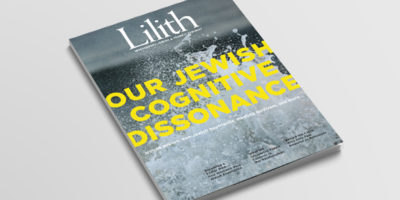What We Save, and Why We Save It
Number One on the New York Times nonfiction bestseller list is The Life-Changing Magic of Tidying Up, by Marie Kondo (not Jewish, in case you were wondering). You’ve read the book? Me too. It changed, maybe forever, the way I fold my underwear and line up my t-shirts. The book’s guiding injunction (Japanese folding tricks aside) is Discard. And while I love the idea of simplifying my closets -— though not so much my bookshelves, thank you -— I believe that in Kondo’s approach lurks some potential danger. It’s one thing to thank objects for their service to you before you find them a new home, as she suggests. But discarding can delete history that cannot easily be recaptured.
Let’s start with domestic stuff we no longer use. For instance, your family-heirloom meat grinder with all its parts, the silk trousseau lingerie that dates back 90 years, that long dress with Arab embroidery from the shuk in Jerusalem, circa 1970. (Um… these are all hypotheticals, of course.) If one were to simply cast off these things, stories about the ways women lived and worked would vanish too. Look, and you’ll notice objects that get discarded are often those connected to women’s lives. Items for cooking and sewing, handicrafts, clothing. All part of what’s designated as material culture. As you know, the really important stuff -— business transactions, legal documents, the backbone of the lives of many men through the ages (hold off on the class analysis for a minute) -— gets saved routinely. And so we’ve lost a big chunk of women’s history. Even feminism’s rise over the past half century has been imperfectly documented.
Historian Joyce Antler, whose work, like Lilith’s, focuses on the intersection of the women’s movement and Jewish identity, describes Lilith as “an important place to go if you want to know anything about the story of how Jewish women have participated in the world since 1976. It provides a marvelous window to the Jewish community…. It’s an archival gold mine.”
Lilith, largely intentionally, has kept from history’s dustbin a significant collection of epehmera like ’zines and early feminist hagadas, invitations to sisterhood programs and protest marches, fan mail and notes from editorial meetings. All in the service of Lilith’s mission to drive gender justice, inclusivity and women’s rights in Judaism, while speaking with a Jewish voice on a whole range of women’s issues.
But lest you (or Marie Kondo) fear that we’re choking on the dust of the ages in Lilith’s office, I come bearing good news. Our collection of paper files, objects, photos, recordings and more has been acquired by the special collections library at Brandeis University, my alma mater, thanks to the generosity of Elaine Reuben, a Lilith supporter who is also a Brandeis alumna.
The Lilith collection will be available to scholars, and the university anticipates (as we do, too) that these files will be a real treasure for people interested in tracking the history of feminism in Jewish life, the vagaries of nonprofit journalism in print and online, the development of iconic stories appearing in Lilith, and more.
(Speaking of those stories…here’s a reminder: every back issue of the magazine is available free to Lilith subscribers in the online archive at Lilith.org.)
Lilith has pioneered writing on a range of once-taboo and now still controversial subjects: family violence, rabbinic sexual misconduct, the shifting timeline of women’s reproductive choices, among others. Like you, Lilith’s writers look for nuance and want to know the complex backstories. The “Jewish cognitive dissonance” narratives in this issue are revealing examples. Lilith not only reports the facts, but intentionally sees their complexity, interprets them and illuminates new paths to empathy and action, and the Lilith papers show the evolution and shaping of the content you read in every issue.
Which may explain why I’ve had mixed feelings about that book on tidying.
In our tidy email culture we no longer have generations of letters between authors and editors, changes and refinements which were parsed with vigor and sometimes even recorded on vellum stationery. Now it’s the final version of an emailed, track-changed manuscript that survives. But it’s terrific fun to see what came before the finished product.
Each of the 800+ files in the Lilith collection is part of this narrative. How did Lilith’s hair issue come to be? And what was the fallout from our reporting on bad behavior by rabbis? What about the particularly Jewish take on abortion rights and new reproductive technologies? And edgy subjects, like the special challenges facing deaf Jewish women, new rituals for gender transition, mothers who relinquished their children for adoption, the political power Jewish women wield with our philanthropy.
Here’s why the university wanted this collection: “With an editorial staff that established from the outset its willingness to take risks, the magazine has continuously addressed controversy directly, celebrating and critiquing how Jews live now. The archive constructs a powerful narrative around the genesis and development of Lilith as a Jewish feminist publication, as well as the magazine’s ongoing role in exploring Jewish identity, including and documenting the experiences of Jewish women and amplifying voices rarely heard.”
The issue you’re reading today is part of the continuing story. Don’t throw it out when you’re done! Thank it for its service to you and pass it along to the next reader. Please.



